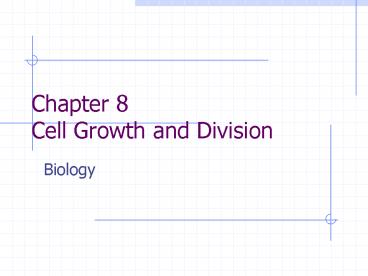Chapter 8 Cell Growth and Division - PowerPoint PPT Presentation
1 / 42
Title:
Chapter 8 Cell Growth and Division
Description:
Chapter 8 Cell Growth and Division Biology 10-1 Cell Growth Adults don t have bigger cells than kids they just have MORE of them Why don t cells just grow bigger? – PowerPoint PPT presentation
Number of Views:83
Avg rating:3.0/5.0
Title: Chapter 8 Cell Growth and Division
1
Chapter 8Cell Growth and Division
- Biology
2
10-1 Cell Growth
- Adults dont have bigger cells than kids they
just have MORE of them
3
Why dont cells just grow bigger?
- DNA overload.DNA would need extra copies to
handle information demand - Too difficult to get enough nutrients and oxygen
IN and waste products OUT
4
- The world's tallest man in 2007 79,
- Bao Xishun and his 56 wife
- most peoplewith acromegalic gigantism eventually
die because of complications fromheart problems.
- "Keeping the blood going round such an enormous
circulationbecomes a huge strain for the heart,"
5
What would happen? Calculate ratio of surface
area to volume
- L W of sides surface area
- L W H Volume
- Practice problem if cell was a cube and its
sides were 1cm each .figure SA? - Figure V
- What if the cell were 3cm? SA? V?
- What is the ratio?
6
Volume increases faster than surface area
- 1166 SA
- 1111 V
- Ratio 61
- 33654 SA
- 33327 V
- Ratio 5427 reduce 21
- The decrease in ratio of SA to V- makes it harder
for the cell to move needed products in and out.
7
Cell division solves
- The problem of information storage because each
daughter cell gets its own DNA - The problem of being too big and inefficient
because although the cell grows some daughter
cells will still be smaller than the parent
8
10-2 Cell Division is mitosis4 sections of the
cell cycle G phases, S phase, mitosis,
cytokinesis
9
10
In Bacteria prokaryotes
- Have circular DNA
- And only 1 piece of DNA called plasmid
- The process by which bacteria reproduce is called
binary fission (not mitosis)
11
10-2 Cell Division
- In eukaryotes the chromosomes carry the genetic
information and they live inside the nucleus - Chromosomes are made up of DNA and proteins
(called histones)
12
(No Transcript)
13
Centromere is made of proteinSpindle fibers are
made of microtubulessister chromatids are
duplicate halves
14
Karyotype-
- Tells of chromosomes in that body cell
15
(No Transcript)
16
(No Transcript)
17
Growth Repair
18
19
Interphase
- Baby Cell (daughter cell) grows and matures
hereand eventually is mature enough to divide - a.k.a.time in between cell division
20
21
3 steps of Interphase
- G1- cell grows, and makes new proteins and
organelles - S phase- DNA is replicated
- G2- molecules and organelles needed for cell
division are produced.
22
Now ready for MitosisPMAT
- Prophase-
- longest,
- chromosomes become visible/
- centrioles go to the poles
- Spindle fibers start to form
- Nuclear envelope starts to break down
23
24
Mitosis.
- Metaphase (middle)
- Last only a few minutes
- Chromosomes line up across the MIDDLE of the cell
- Centromeres connect to the spindle fibers
25
26
Mitosis
- Anaphase (the fingers)
- Centromeres split , splitting chromosomes into 2
sets - Chromosomes move away from each other to the
poles- being pulled by spindle fibers
27
28
Mitosis
- Telophase (the peanut)
- Chromosomes begin to disappear from view
- Nuclear envelope re-forms
- Spindles break apart
- Nucleolus reforms
- end mitosis
29
(No Transcript)
30
Cytokinesis
- Nucleus and contents have split but what about
the rest of the cell.? - Cell membrane is drawn inward until cytoplasm is
eventually pinched into two equal parts - In plants cell plate eventually becomes the cell
wall
Cell plate gt
31
http//www.biostudio.com/d_20Mitosis.htm
32
10-3 Regulating the Cell Cycle
- Cell growth and cell division are carefully
controlled - Cells grow when there is space , then when they
bump into other cells they stop - A cut in your hand?
33
- http//www.pearsonsuccessnet.com/snpapp/iText/prod
ucts/0-13-181118-5/ch10/sb4501f1.html
34
What signals the cell to start dividing?
- A set of proteins called cyclins control the
timing of cell division - Internal Regulators- tell cell to divide based on
what is happening inside the cell (PMAT timing) - External Regulators- tell cell to divide based on
what is happening outside the cell (wound healing
, embryonic development)
35
Cancer
- A disorder in which some of the bodys own cells
(whose DNA is damaged) lose the ability to
control growth - Cells grow out of control and form masses called
tumors - Sometimes these cells break free and spread
throughout the body - These cells lack the proteins that tell them to
stop growing and ignore the bordering cells
telling them to stop
36
Causes of Cancer
- Viral Infection (commercial)
- Radiation (sun, x-rays )
- Smoking tobacco
- Anything known to cause cancer cells to develop
is called a carcinogen.
37
Identifying the Number of Chromosomes
- Not all living things have the same number of
chromosomes.. - Humans 46
- Fruit flies 8
- Carrots 18
- worksheet
38
Haploid vs Diploid
- Haploid half
- Diploid Double
- But first figure out where you are at?
- Body cell(regular cell) is already Diploid
- Sperm/egg cell (sex cell) is already Haploid
39
Differences between animal and plant cells-
- Plants have a cell wall and a cell membrane- so
when they pinchits called a cell plate. - The cell plate becomes the cell membrane then
the cell wall develops next.
Cell plate gt
40
(No Transcript)
41
The End
42
(No Transcript)































